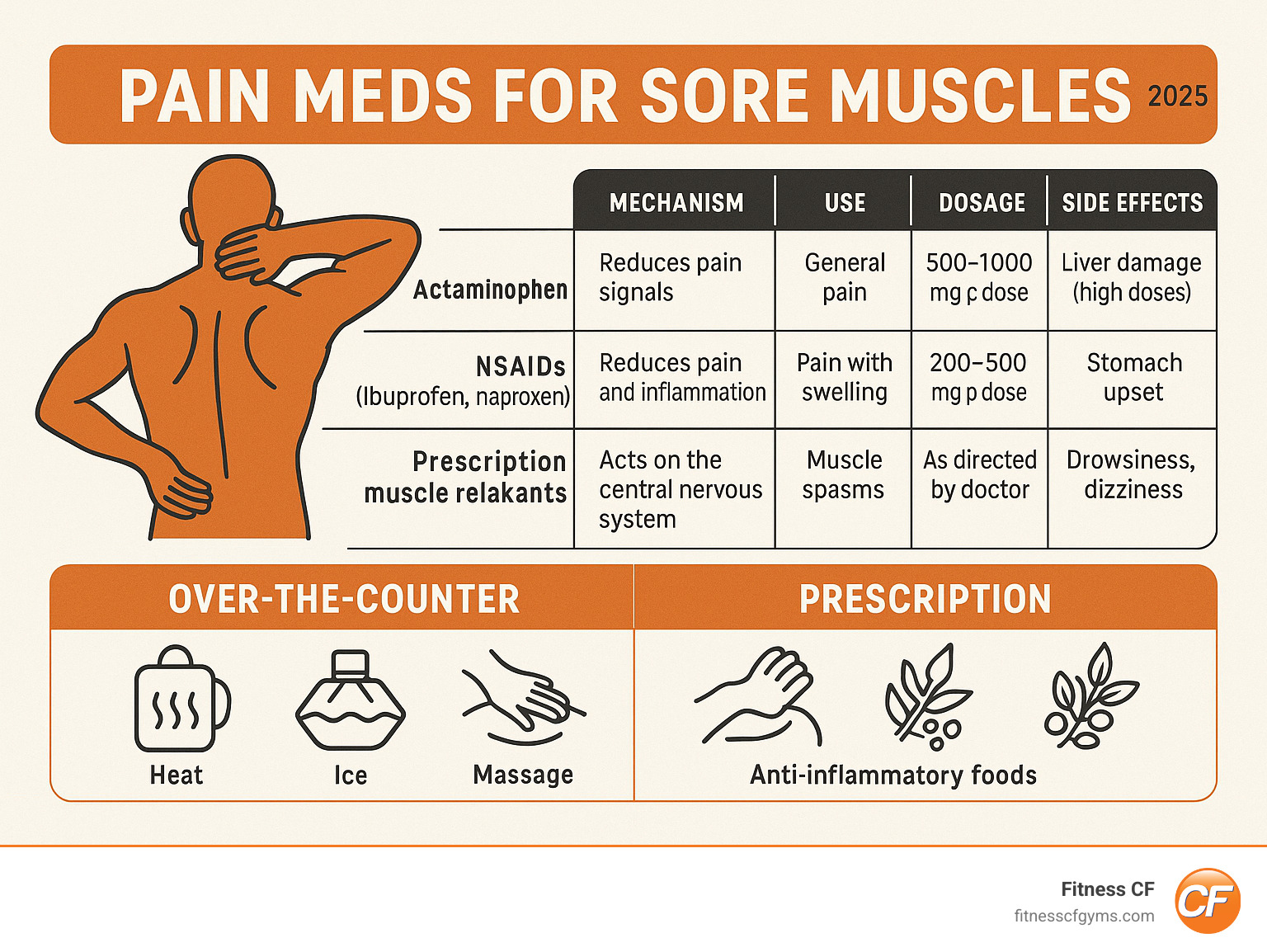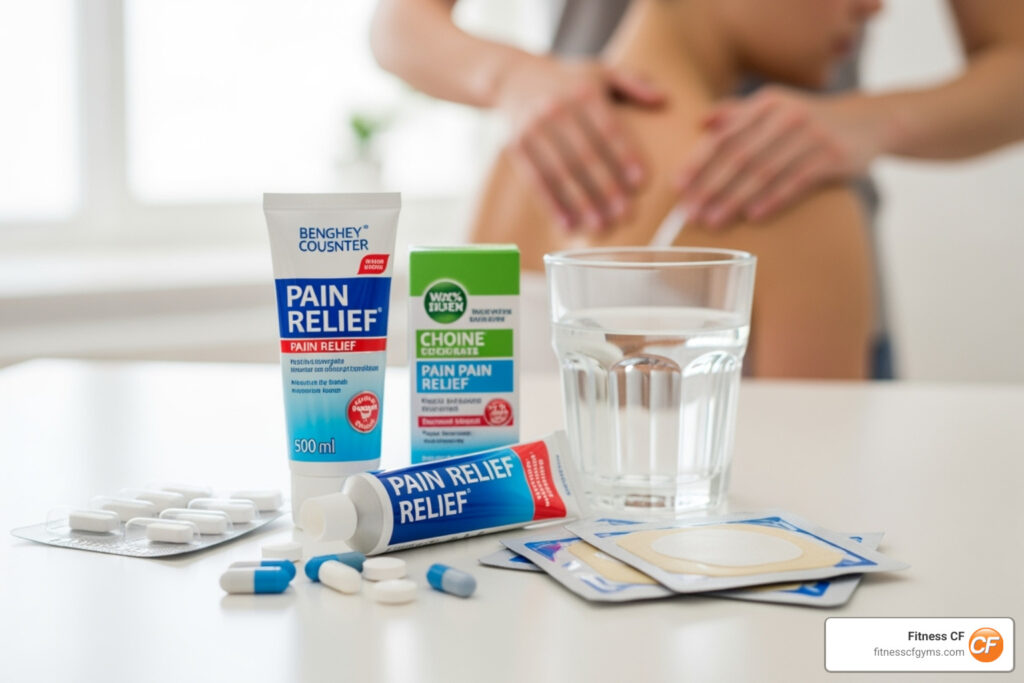Understanding Your Options for Muscle Pain Relief
Pain meds for sore muscles come in several forms, each working differently to help you manage post-workout soreness or everyday aches. The right approach can make all the difference.
Quick Pain Relief Options:
- Acetaminophen – Best for general pain relief without inflammation
- NSAIDs (Ibuprofen, Naproxen) – Ideal for pain with swelling and inflammation
- Prescription muscle relaxants – For severe spasms or chronic conditions
- Natural remedies – Heat, ice, massage, and anti-inflammatory foods
The key is matching your treatment to your specific type of muscle pain, as mild soreness from exercise responds differently than acute muscle spasms or chronic conditions.
With over 40 years in the fitness industry, I’ve learned that the best approach combines smart medication choices with proven recovery strategies to help people balance recovery with staying active.

What is Muscle Soreness and Why Does It Happen?
That familiar ache after a challenging workout is something every fitness enthusiast knows well—and it’s a sign of progress.
Delayed Onset Muscle Soreness, or DOMS, is your body’s natural response to exercise that challenges your muscles in new ways. It typically appears 12 to 24 hours after exercise and can last several days.

When you exercise or try new movements, you create microscopic tears in your muscle fibers. This is a normal and necessary part of building strength. These tears result from mechanical stress, not lactic acid buildup as is commonly believed.
Your body responds with an inflammation process, sending repair crews to the affected areas. This process brings increased blood flow and nutrients to rebuild your muscles stronger, but the inflammation itself causes the tender, stiff feeling of soreness.

This soreness is a normal exercise response, not an injury. Normal muscle soreness is a dull, widespread ache that improves with gentle movement. Pain from injury is often sharp, sudden, localized, and may worsen with movement, sometimes with visible swelling or bruising. Understanding this difference helps you decide when to use pain meds for sore muscles versus when to seek medical attention.
Choosing Over-the-Counter Pain Meds for Sore Muscles
When muscle soreness strikes, over-the-counter (OTC) pain meds for sore muscles can be effective. However, not all pain relievers work the same, and choosing the right one makes a significant difference in your recovery.
The two main types of OTC pain relievers are acetaminophen (Tylenol) and NSAIDs like ibuprofen (Advil, Motrin) and naproxen (Aleve). Acetaminophen works by blocking pain signals to the brain and reducing fever, but it doesn’t directly address inflammation. NSAIDs, however, reduce pain, fever, and inflammation by blocking chemicals called prostaglandins. This dual action makes them particularly useful for muscle soreness that comes with inflammation.
Here’s a quick comparison to help you understand your options:
| Feature | Acetaminophen | NSAIDs (Ibuprofen, Naproxen) |
|---|---|---|
| Mechanism | Blocks pain signals, reduces fever | Reduces pain, fever, and inflammation |
| Best For | General aches, headaches, fever | Muscle pain with swelling, strains, post-workout soreness |
| Potential Risks | Liver damage with overuse | Stomach upset, kidney issues, heart risks |
Source: Pain Relievers: Understanding Your OTC Options
Acetaminophen vs. NSAIDs: Which is Right for You?
Matching the medicine to your specific situation and health needs is key.
If you have general muscle aches without much swelling, acetaminophen may be a good choice as it’s gentler on the stomach. When muscles are swollen and tender, NSAIDs like ibuprofen or naproxen are usually more effective due to their anti-inflammatory properties.
Your health history is crucial. If you have liver concerns, use acetaminophen with caution. If you have heart disease, high blood pressure, or kidney problems, NSAIDs might not be the best option. They can also interact with certain medications and may not be ideal for older adults.
While pain relief is the goal, the anti-inflammatory effects of NSAIDs often make them better for most post-workout soreness. Always consider your personal health history when choosing.
Safe Usage and Recommended Dosages for OTC Pain Relievers
Reading labels is a critical safety measure. Even common OTC pain meds for sore muscles can be harmful if used incorrectly.
For acetaminophen, adults should never exceed the maximum daily dose of 3,000-4,000 mg (check the product label). Be aware that acetaminophen is in many combination cold and flu products, increasing the risk of accidental overdose and serious liver damage, a concern highlighted by the FDA in their update, Don’t Overuse Acetaminophen.
For NSAIDs like ibuprofen, stick to 200-400 mg every 4-6 hours, with a daily limit of 1,200 mg unless a doctor advises otherwise. Always take with food or milk to protect your stomach. Naproxen lasts longer and should be used carefully.
Both medication types are for short-term use. If your soreness doesn’t improve after a few days, it’s time to talk to a healthcare provider.
When to Consider Prescription Medications
When severe muscle pain or intense spasms aren’t helped by OTC options, it might be time to talk to your doctor about prescription pain meds for sore muscles. This may be necessary for a significant muscle pull or chronic spasms that interfere with daily life.
Your doctor has several options. Higher-dose NSAIDs can tackle more significant pain and inflammation. Muscle relaxants are designed to calm spasming muscles. Antispasmodics like cyclobenzaprine (Flexeril) work on the central nervous system to reduce contractions. Antispastics like baclofen (Lioresal) work differently and are typically for chronic conditions like multiple sclerosis.
In severe cases, like major injury or post-surgery, doctors might briefly prescribe opioids like oxycodone, but these are rarely used for typical muscle soreness due to high addiction risks.

Risks of Prescription Muscle Relaxants and Painkillers
While effective, prescription medications are powerful tools with significant risks that require medical supervision.
Drowsiness and dizziness are the most common side effects of muscle relaxants, so do not drive or operate machinery until you know how the medication affects you. Other side effects include fatigue, nausea, headaches, and dry mouth. More serious but less common effects include fainting or blurred vision.
Some muscle relaxants, particularly carisoprodol (Soma) and diazepam (Valium), carry a risk of addiction and dependence. They are controlled substances, and stopping them suddenly can cause withdrawal. If you have concerns about dependence, talk to your healthcare provider immediately.
Combining muscle relaxants and alcohol is extremely dangerous. Both are central nervous system depressants, and the combination can lead to severe dizziness, low blood pressure, memory loss, and potentially fatal respiratory depression.
Opioids have their own serious risks, including severe constipation, nausea, and an extremely high potential for addiction. Prescription pain meds for sore muscles require medical supervision to be used safely.
Beyond the Pill: Proactive Strategies for Muscle Recovery
While pain meds for sore muscles offer temporary relief, a holistic approach that supports the body’s natural recovery process is key to long-term fitness. This involves smart lifestyle choices and non-drug treatments.

Light activities can increase blood flow to muscles, delivering nutrients and removing waste products, which helps you return to your fitness routine faster. To learn more about optimizing your post-workout routine, check out The Best Recovery Practices After a Tough Workout.
The Role of Diet, Hydration, and Sleep
Diet, hydration, and sleep are crucial for muscle recovery. A diet rich in anti-inflammatory foods like cherries, strawberries, and avocados can help. Lean proteins provide the building blocks for muscle repair. For more on fueling your body, read about Good Things for Muscle Recovery.
Hydration is also paramount. Ensure good hydration by balancing water with electrolytes, as even mild dehydration can impair recovery and worsen soreness.
Finally, sleep is non-negotiable. During deep sleep, our bodies release growth hormone, vital for tissue repair. Adults generally need at least 7 hours of sleep for optimal recovery.
Movement and Therapies for Relief
Beyond diet and rest, specific movements and therapies can actively promote muscle recovery.
- Gentle Stretching: Light stretching improves flexibility and blood flow. Avoid intense stretching on very sore muscles. For guidance, see Stretching 101: What to Do Before and After Your Workout.
- Foam Rolling: This self-myofascial release technique can help break up muscle knots and ease tightness.
- Massage: Massaging sore areas can relieve pain by relaxing tissue and improving circulation.
- Ice and Heat Therapy: For acute soreness, ice packs can reduce swelling. Many athletes use ice baths for recovery. Find out more about Why Are Ice Baths Good for Muscle Recovery?. For stiffness, heat can relax muscles.
- Active Recovery: Light exercise like walking or cycling on recovery days helps flush out metabolic waste without adding stress.
Knowing Your Limits: When to See a Doctor
It’s crucial to distinguish between normal post-workout soreness and pain that signals a more serious issue.
Normal muscle soreness is a dull, widespread ache that develops 12-24 hours after exercise and improves with time and gentle movement. Serious injury pain is often sudden, sharp, and localized, and may worsen with movement.
Seek medical attention if your pain is sharp and sudden, or if there’s significant swelling, bruising, or redness. You should also see a doctor if the pain lasts more than 72 hours without improving, despite rest and self-care.
Urgent symptoms include being unable to move a limb or put weight on it, experiencing numbness, tingling, or weakness, or if the pain developed after a fall or direct impact. These can indicate serious tissue or nerve damage that needs professional evaluation.
If pain interferes with daily activities or your exercise form, it’s worth getting it checked by a professional to rule out a minor injury that could worsen.

What are the risks of long-term use of pain meds for sore muscles?
Relying on pain meds for sore muscles long-term can cause significant health problems.
NSAIDs like ibuprofen carry risks of stomach problems, from heartburn to bleeding ulcers. Kidney damage is another serious concern with long-term NSAID use, as our kidneys must work hard to process them. The National Institute of Diabetes and Digestive and Kidney Diseases offers more information on Keeping Kidneys Safe: Smart Choices about Medicines.
Some NSAIDs also carry cardiovascular risks with long-term, high-dose use, potentially increasing the chance of heart attack or stroke.
Acetaminophen has its own serious long-term risk: liver damage from overuse.
Chronic use can also mask underlying injuries that need proper treatment. Furthermore, some research suggests regular NSAID use may interfere with the muscles’ natural healing process.
Special Considerations for Pain Relief
Not everyone can safely use the same pain meds for sore muscles.
Pregnancy requires extra caution; acetaminophen is generally considered safe, but NSAIDs should be avoided, especially in the third trimester.
For children and teenagers, aspirin is off-limits due to the risk of Reye’s syndrome, a serious illness. Dosing for children should always be confirmed with a pediatrician.
Older adults face increased risks from NSAIDs, particularly stomach and kidney issues.
People with liver or kidney problems, heart disease, or high blood pressure need to be especially careful with pain relievers. Those with bleeding disorders or on blood thinners should also be cautious with NSAIDs.
Always consult a healthcare provider to discuss your medical history before starting any pain management routine.
Build a Resilient Body to Prevent Soreness
The best way to manage muscle soreness isn’t just finding the right pain meds for sore muscles; it’s building a resilient body. Think of each workout and recovery day as an investment in your long-term health.
Strength training is your secret weapon. Regular resistance exercise makes muscle fibers, tendons, and ligaments more resilient to stress. It also improves bone density, boosts metabolism, and makes daily tasks easier.
Cardiovascular health is also vital. A fit heart and lungs efficiently deliver oxygen and nutrients to your muscles, which aids recovery by helping to flush out metabolic waste that contributes to soreness.
Flexibility and mobility work keeps muscles supple and joints moving freely, reducing the risk of strains and tears. Better flexibility can also improve your form during workouts, further reducing injury risk.
Consistency in your exercise routine is key. A regular schedule allows your body to adapt, leading to less soreness and faster recovery. However, consistency includes planned recovery. As we discuss in The Role of Recovery: Why Rest Days Are Just As Important As Workouts!, your body gets stronger during rest.
At Fitness CF, we believe a strong, well-conditioned body is the best defense against injury and soreness. By focusing on strength, cardio, flexibility, and consistent training with proper recovery, you can dramatically reduce your dependence on pain meds for sore muscles.
Modern techniques can also accelerate healing. For instance, you can explore recovery options like HydroMassage, which combines massage benefits with modern convenience.







